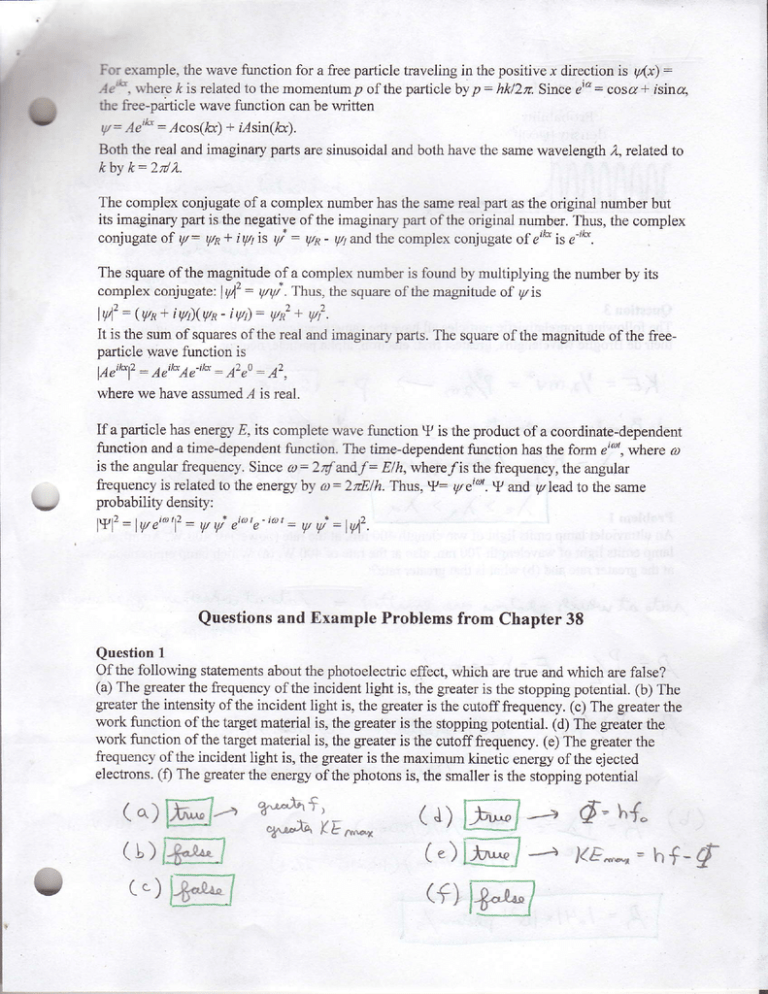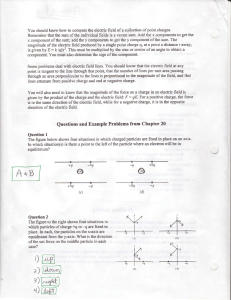solutions
advertisement

r.
For example,the wavefirnction for a fiee particle traveling in the positivex directionis r2(;r):
p of the particlebyp = hkl2z, Sincee'o: cosa* lsina,
Ae^, whereft is relatedto the momentum
the free-paiticlewavefunction canbe written
V= Ae'o : Acos(k) + iAsin((a).
Both the real and imaginaryparts aresinusoidalandboth havethe samewavelength2, relatedto
kby k:22d2.
The complexconjugateofa complexnumberhasthe samereal part asthe original numberbut
its imaginarypart is the negativeof the imaginarypart of the original number.Thus,the complex
tl/R- W a\dthe complexconjugateof e'k is e-'k.
conjugateof ry: typ+ itylis f:
The squareof the magnitudeof a complexnumberis found by multiplying the numberby its
complexconjugate:lAt: Vi. Thus,the squareof themagnitudeof qzr
is
lv4': (v^+ivl(vn- iwD:vi + ,y?.
It is the sum of squaresofthe real andimaginaryparts.The squareofthe magdtudeofthe freeparticlewavefunctionis
14"'bl2: A"tbA"-ib: A2eo: 42,
where we have assumedI is real.
v
If a particle has energyE, its completewave function Y is the product of a coordinate-dependent
function and a time-dependent function. The time-dependent firnction has the form ei't, wnere a)
is the angular frequency. Since ar 2nf nd.f: Elh. where/is the frequency, the angular
frequencyis relatedto the energyby at:2rE/h. Thus, Y: tyei''.V and,r4leadto the same
probability density:
= ,y yl ei''e'''t = ,/ =1,//'.
lYl' : lrlr
i
"t''l'
Questionsand Example Problems from Chapter 38
Question1
Ofthe following statementsaboutthe photoelectriceffect,which aretrue andwhich arefalse?
(a) The greaterthe frequencyofthe iacident light is, the greateris the stoppingpotential.(b) The
greaterthe intensityofthe incident iight is, the greateris the cutoff frequency.(c) The greaterthe
work function ofthe targetmaterial is, the greateris the stoppingpotential.(d) The greaterthe
work function of the targetmaterial is, the greateris the cutoff frequency.(e) The $eater the
frequencyof the incidentlight is, the greateris the maximumkinetic enerry ofthe ejected
electrons.(f) The greaterthe energyofthe photonsis, the smalleris the stoppingpotential
(")E-
(!)i+,e-]
(.) i-B-!-]
?^r-&f ,
ta,-la YP,",-"
(r) l}^-](")
d=r*
----),(F,"-,"=
hf-f
(f) i:s-_h/
Question2
In the figure be1ow,why are the minima in the values of I ry I' grealet than zeto?
Probabiliq'.,
densityly(x)l'
^4-eo.toJ Jr.^ra.,{;
ra4af,Aa'n
)*- *.qtUt-*.-$
Ifu rw'rd.o^t
-r rq^,t .&o u-* rl.
r*d q"l
Question3
particlesa1lhavethe samekineticenergy.Rankthemin orderof
Thefollowingnonrelativistic
greatestfrst: electron,alphaparticle,neutron.
their deBrogliewavelengths,
KF= 7lnv"=?h->
P=
!
ur.'.r"I,'.qrg "
,X W-4"
\ = n/f
Q*w"g, a"uar)
{Til'
-^o ";". KE p a,*^" 4o, e-z'.A )
[Ju &,2;,1r, r], J]'o qr-\
?
fa>p">f.
probrem, I\"riJ[l
An ultraviolet lamp emitslight of wavelength400 nm, at the rate (power) of 400 W. An infrared
lamp emitslight of wavelength700 nm, alsoat the rate of 400 W. (a) Which lamp emitsphotons
atthe greaterrateand(b) what is that greaterrate?
A-*" ot *)S,^ A F}J-."
ot'r: -p,vnfid"
=
,-.ta A,',N"A ntn"'l r^-e*'ftt)
-D./t%t'dn \
A = % F--h*=\'/x
A = PYn. ( a) qrvrU \
-- g^P-t 4
Qoonq Xrrn^p ,\aa o/t-lA
(u)
B= >
hc-
= (Ltoo5/e)(1oo,^)
( leto.v".-) (r.a, t6'15/"t)
^-*"
he = lt.tloeV"nm
Problem2
A spectralemissionline is electromagneticradiationthat is emittedin a wavelengthrange
narrow enoughto be takenasa singlewavelength.Onesuchemissionline that is importantin
astronomyhas a wavelengthof 21 cm. What is the photon energyin the electromagneticwave at
that waveleneth?
F=
( o.at*,)
\-'
E = 9.u7,.rd's5
&'t _,r,r"t",tr"g
hc = l?.qO<-V.nn
E=
hc-
4t4'
-
(
l"v
l.6oe.t 5'?s-) -
:
l ?,qO eV"r,cn
\
),.lr lD7 n r.,
5"9 ".lD-"e"V
Problem3
The stoppingpotential for electronsemittedftom a surfaceilluminatedby light ofwavelength
491 nm is 0.710V. Whenthe incidentwavelengthis changedto a new value, the stopping
potentialis 1.43V. (a) Whai is this new wavelength?(b) What is tle work firnction for tle
surface?
\, . t = 4 9 l n c . ,
Vgo, = O.?toV
- \^_F
KE."^":h+-6
6= hy'o_KE^_n\
V,.q'= /'4f V
hc/,
'
.
(E^_t1:
\*^
/ ^,
h.l/
Al
'
^, r.otttfr*l
-1./r
F-Fnvu"a1
)
=-
= l).joeV.or:q
4i= t",/^- KE^._
1Q Inrn
4tt At^b-a
h/x^--'/^,-)(E +KP
___)hy'^-=3.AS. y'
Mt
l?.{o.r,l n- O.?lOeV+ r,q3ev
49lnm
,\*- ht.)s.V-'+#
(u)
s.;
I\"--3sill
- O.?loeV
/l''..rl
Problem4
The wavelengthassociatedwith the cutoff fiequencyfor silver is 325nm. Find the maximum
kinetic energyof electronsejectedfrom a silver surfaceby ultraviolet light of wavelength254 nm
), = ./5,= 3A5n,n ----
f"- />,"
Y&,rn""*U
.t-
.!rr'qel-r++'vrg *A^*
.-4,v*/cr lft,r.a L X\. ntu*l'-*'-^*',
hf" = hy'^"
;;-j,QJ*,1-"**'1 .o-0-l,ri-'''*i,
d:
i-'fh% :
\/
,-l
K
| \ 4fi\.44
-r (A
Y
- n/o.
K^** = h/x
K*,0.*h'/^. *
o.V "o rn
lX4o ei"no* - 12,/t
|,5 I n..,
K
- l,DT e/
3A5or
Problem5
In a photoelectricexperimentusing a sodiumsurface,you find a stoppingpotential of 1'85 V for
a wavelengthof300 nm anda stoppingpotentialof0.820v for a wavelengthof400 nm.
From thesedalafind (a) a value for the Planckconstant,(b) the work function $ for sodium,and
(c) the cutoffwavelength1.6for sodium.
Vr4=
)
1.65V-8-. \=JoDnn
= {oonn1 .2
V"tu" = O"3AoV -{t". \
(") ',a,r,l**t (l)-$""*.,
(t) --+ e(V,-V,)
h=.(Yt!i-
c (/2r,- /2'')
(U) Fri\(r)+(e)
(r)
cV.,o.= h./."- d
())
--r- \
= h. ( .7
At
,\. ,/
----'h=
---: e(V,.V,)
Q-= alr1-v
e-V,qr= h^,-E
tdtt V's
4 .12.,*
=
( c.) O =b f, '=h./^. +
X" = 516',.
l2gacV"r!'
,\, =-> = A.x't-\)
A
Problem 6
Considera collision betweenan x-ray photon of initial energy50.0 keV and an electronat rest,
in which tki photon is scatteredbackward and the electron is knocked forward. (a) What is the
energy of the back-scattered photon? (b) What is the kinetic energy of the electron?
d= rco"
o
11lv-)
E= So.ofev
o-+ ^
€v^\f\
V*.r
A\=
YE'(
E'
A''13^ld'"rq
h/*..=
(\-r^d)
= (2,-u:'lo'"')(t-o'rlo")
= 4 . 8 l o" l d l r - ,
(q)
A = h^
\ ra ) = f,.9?* 1il'rr",--J
\'=
o.oaq!'n..,= A.'.t1,td"n
h./A = ]3jo:!I9*
------\=
'=
\c/,
/^
=
@.oA9J n m
E, = 4.lt".lOq.V _- 4t.8"-V
( b) -Vq
'$ t ,naqft -a
.rr^r-'Xa
KE= 5o-oX"V-t1.8F"y'
problemT
=
( ll alo e V.nr.r
(E"E-E/
8.2,Kev
Gammaraysof photon energy0.511MeV aredirectedonto an aluminumtargetandare scattered
in variousdirectionsby looselyboundelectronsthere.(a) What is the wavelengthof the incident
gammarays?(b) What is the wavelengthof gammarays scatteredat 90.0" to the incident beam?
(c) rMhat is the photon energy ofthe rays scatteredin this direction?
= o"9ll rlobeV
(u)
n\=
./.r/\
h
fieC
h'/g\ =
(") 4:=hf = h.1>*
E = O"5il MeV
>=
(
\1-1'^Q)
"l .),q
O eV "nr.l
\
- a.al3" lo
O"5tr r lDte V
';\ =
1,'r3 p.^
({o.r,3nlo-31T"*')_,
( r_c-o<go.o"J
(1.rt- | D''Fs ) (g.o, io' */s)
\ --+ \'= Xrn\
.__(.)
4.3i" ynr
4:= ht' = h*.
E=
I A2Jo e.V. or.r
4.8U:" lOt.'-
- n"r
A= O.a55M*-V
Problem8
A bullet of mass40 g travelsat 1000m/s.Althoughthebullel is clearlytoo largeto betreatedas
a matterwave,determinewhatEq. 38-13predictsfor its de Brogliewavelength.
rq = 4o? = a/D.O-tOsFa
V = loDo 1.'-rfe
X=?
+
^Ia l}:*:A",tlru"*u"gi*
,= YP
X= Y*"
\
(t"-ca*lo-t95-s)
=
( ' t " o . 15 " K e ) ( t a o o o / s )
\
=
l-?x 1o-35 ,1-.,
Problem9
A nomelativisticparticle.ismoving tfueetimes asfast asan electron.The ratio of the de Broglie
wavelengthof the particle to that of the electronis 1.813 x 104.By calculatingits mass,identiff
'
the oarticle.
Vno^rr* = 3 Vrr,.r-
\
< 1.8t3^loe -s
*-,
X rnx-
)6rv,
-- l.rr3,"tdl
--..-_
)Y
fn"Va
/r.'^
\
r/Va
\
Ci:-J(a)
= r'z'3^rd{
- - - --)
t' t/a
/ m' \
--)
5 . 43 1 ' r d q
5 . 1 3 1 *I d {
. /l,.tl3*loj) = 5.,131't61
(--m;J= o(
NF= l,t"7tl1*fd"Fa
Fa"_E&;i
q rndho".
Problem l0
lmagine playingbaseballin a universe(not ours!) wherethe Planckconstantis 0.60 J.s. What
would be the uncertaintyin the position ofa 0.50 kg baseballthat is moving at 20 rnls along an
axisifthe uncertaintyin the speedis 1.0m/s?
fiAV
h= 0.bD5's
AP=o(tn")=
FD: O"5oY+
A P = (o.soYgXt.o./s) - o"50 fg .o/s
Ax=?
Lv = l-ee/s
1,l^\rr,,fia,,.4
0",i'-b.0 i
AX? -L
|rrDf
Axz
AX Ap_: t-
Ax Al*l
\fe,
r
( o-co 5-'7
A.rr (o.so$"/)
f*il]
ProblemI 1
A 1500kg garmsving at 20 rnls approaches
a hill that is 24 m high and 30 m long. Although the
car and hill areclearlytoo largeto be treatedas matterwaves,determinewhat Eq. 38-21predicts
for the transmissioncoefficient of the car,asif it couid tunnelthroughthe hill as a matterwave.
Treatthe hill asa potential energybarrierwherethe potentialenergyis gravitational.
rn - / SooPg
U = rnlb = ( tso.)9) (q.zo/s')(el^) = 3'5J*lo5T
'/xrnv*=
7a(ro".pr;1Lontls)^= 3.o,ri o5T
E=
V = AO..r/s
l"' : ?'{m
-AKL
4 = 3on'
J-=;"-
K=
K=Irri"q(u-e)
v
h*
s)
8 rrr ( tsoofc) (s"ga,, os:- :.ox 16e
(6.t'=*,o-3if,-.s)
K = l.t8*lo35r;'
T
-LXL
I = e
=O
a
l''
Problem 12
consider a potentialenergybarrier like that ofthe figure below but whoseheight Ui is 6.0 ev
andwhosethicknessL is 0.70 nm. What is the energyof an incident electronwhosetransmission
coefEcientis 0.0010?
l)"=
(""o<-V
L=
O"?on.
7 = o.ooto
E=?
.i.------------=_-,
-T.>,
- a.KL
e
=
- ?.L
LbJL* -
*
e
-J
L'l
errar"i(u"-a
h*
3'rratq(U'-A)
oo tl
"r" (\)"-g)
l\
n
1L^
(u"-r) = J,:!*?* ----'E= oo
n^')
( 1L') (g
b'(.p"rTI"
3e rI-Ltrt
hc.= laqDe-v'nm
g1,'n*l*(m.ct)
E = G"oov
( Tlrr o at/.n,n)"(ir_a:o9lg.D
3ln* (o.?o",')\ ( o . 5 l l x l o b e V )
A= 5.I.V
i
I



